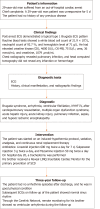Brugada syndrome associated with out-of-hospital cardiac arrest: A case report
- PMID: 34307588
- PMCID: PMC8283591
- DOI: 10.12998/wjcc.v9.i19.5345
Brugada syndrome associated with out-of-hospital cardiac arrest: A case report
Abstract
Background: Brugada syndrome (BrS) is an inherited disease characterized by an electrocardiogram (ECG) with a coved-type ST-segment elevation in the right precordial leads (V1-V3), which predisposes to sudden cardiac death (SCD) due to polymorphic ventricular tachycardia or ventricular fibrillation in the absence of structural heart disease. We report the case of a 29-year-old man with out-of-hospital cardiac arrest. BrS is associated with a high incidence of SCD in adults, and increasing the awareness of BrS and prompt recognition of the Brugada ECG pattern can be lifesaving.
Case summary: A 29-year-old man suffered from out-of-hospital cardiac arrest, and after defibrillation, his ECG demonstrated a coved-type elevated ST segment in V1 and V2. These findings were compatible with type 1 Brugada pattern, and ECG of his brother showed a type 2 Brugada pattern. The diagnosis was BrS, NYHF IV, multiple organ dysfunction syndrome, sepsis, and hypoxic ischemic encephalopathy. The patient had no arrhythmia episodes after discharge throughout a follow-up period of 36 mo.
Conclusion: Increasing awareness of BrS and prompt recognition of the Brugada ECG pattern can be lifesaving.
Keywords: Brugada syndrome; Case report; Electrocardiogram; Family history; Out-of-hospital cardiac arrest; Ventricular fibrillation.
©The Author(s) 2021. Published by Baishideng Publishing Group Inc. All rights reserved.
Conflict of interest statement
Conflict-of-interest statement: The authors declare that they have no conflict of interest to report.
Figures



References
-
- Brugada P, Brugada J. Right bundle branch block, persistent ST segment elevation and sudden cardiac death: a distinct clinical and electrocardiographic syndrome. A multicenter report. J Am Coll Cardiol. 1992;20:1391–1396. - PubMed
-
- Juang JM, Huang SK. Brugada syndrome--an under-recognized electrical disease in patients with sudden cardiac death. Cardiology. 2004;101:157–169. - PubMed
-
- Sieira J, Dendramis G, Brugada P. Pathogenesis and management of Brugada syndrome. Nat Rev Cardiol. 2016;13:744–756. - PubMed
-
- Sieira J, Brugada P. The definition of the Brugada syndrome. Eur Heart J. 2017;38:3029–3034. - PubMed
Publication types
LinkOut - more resources
Full Text Sources

